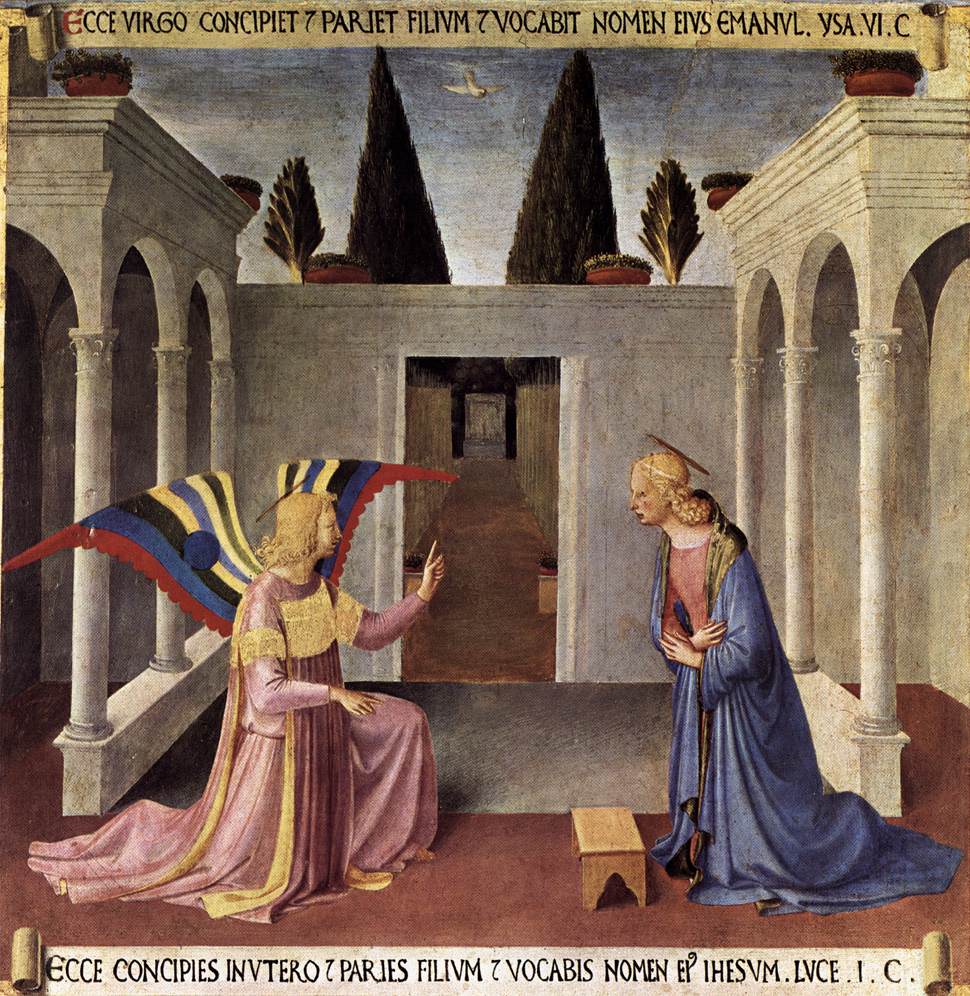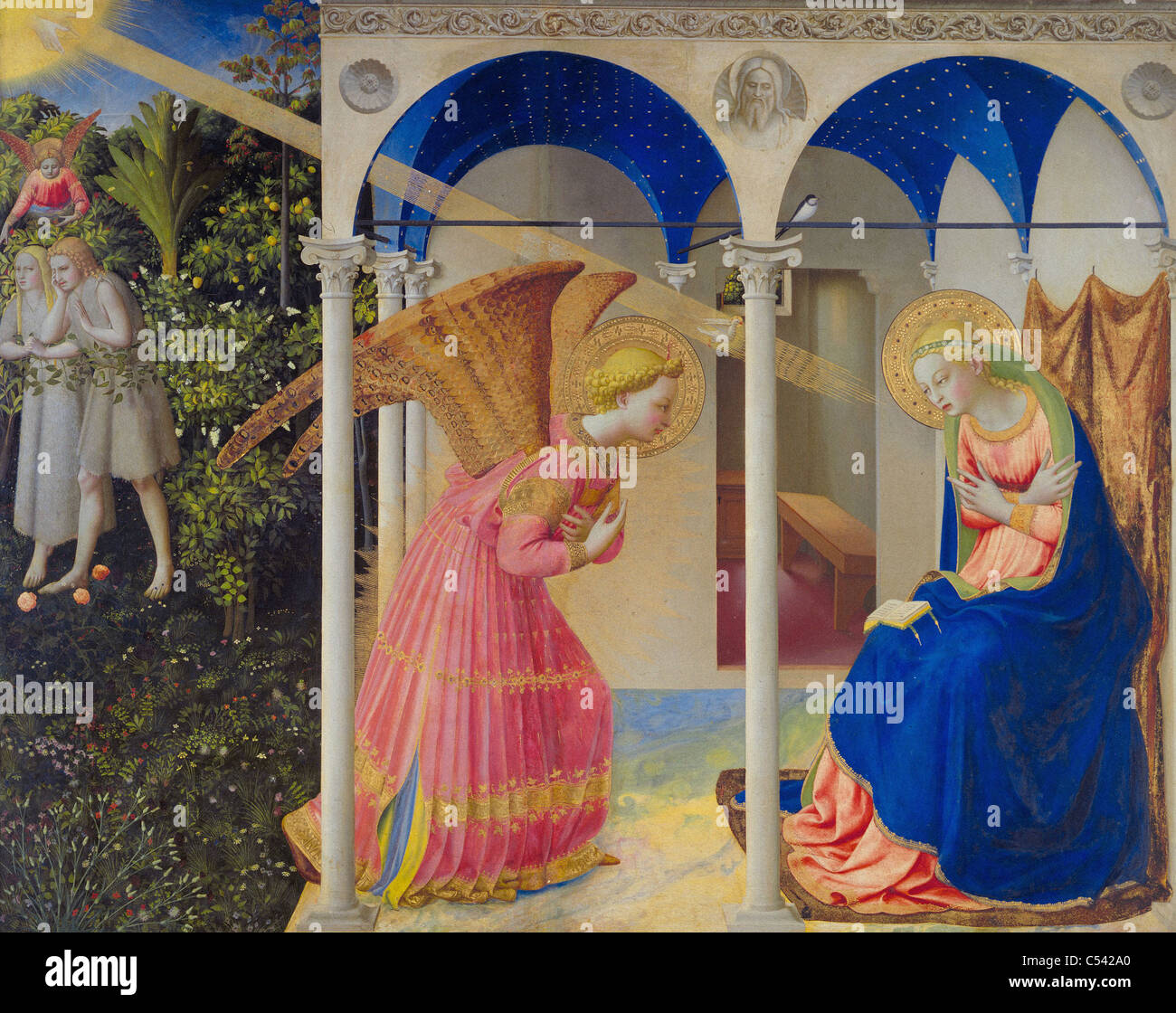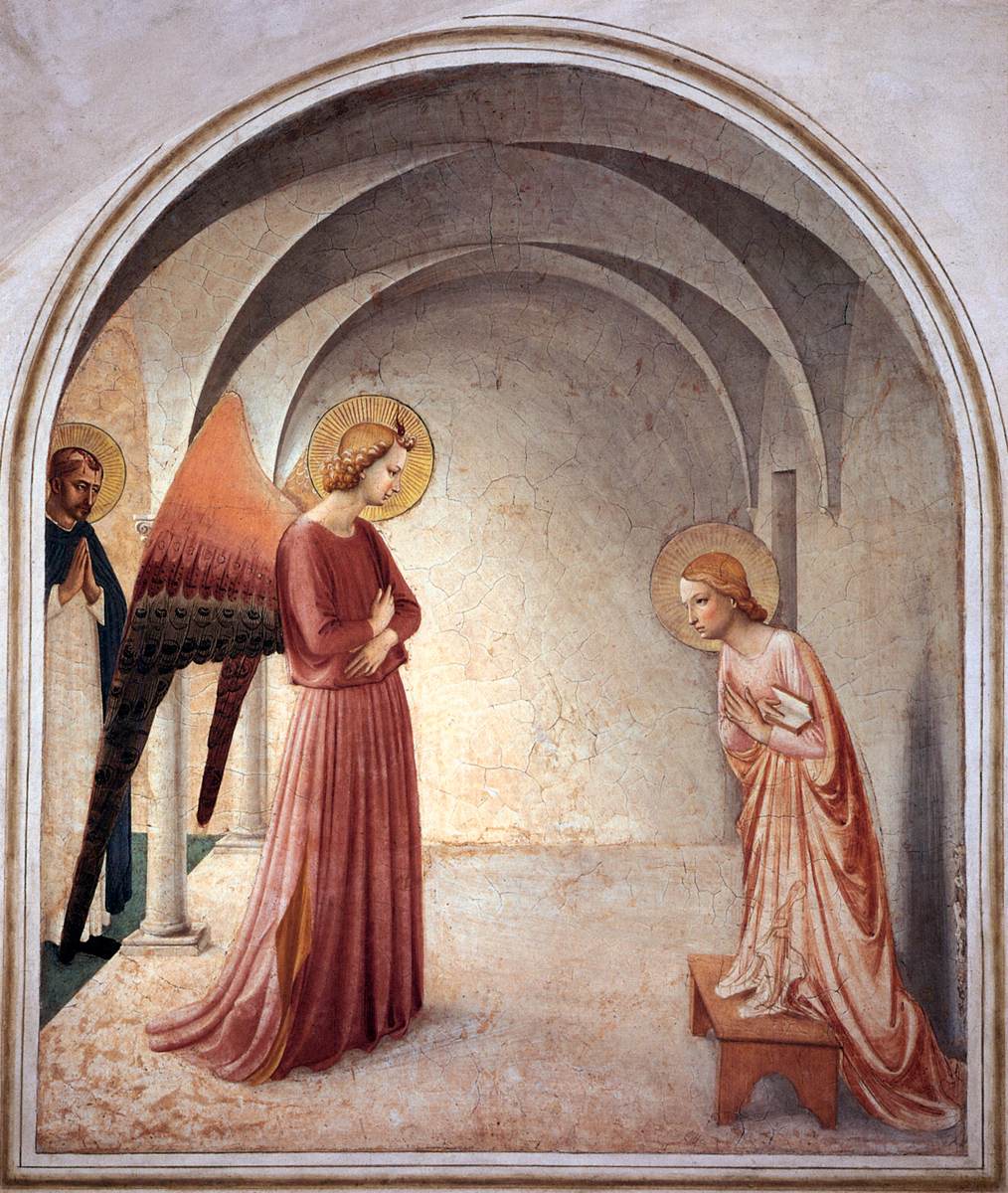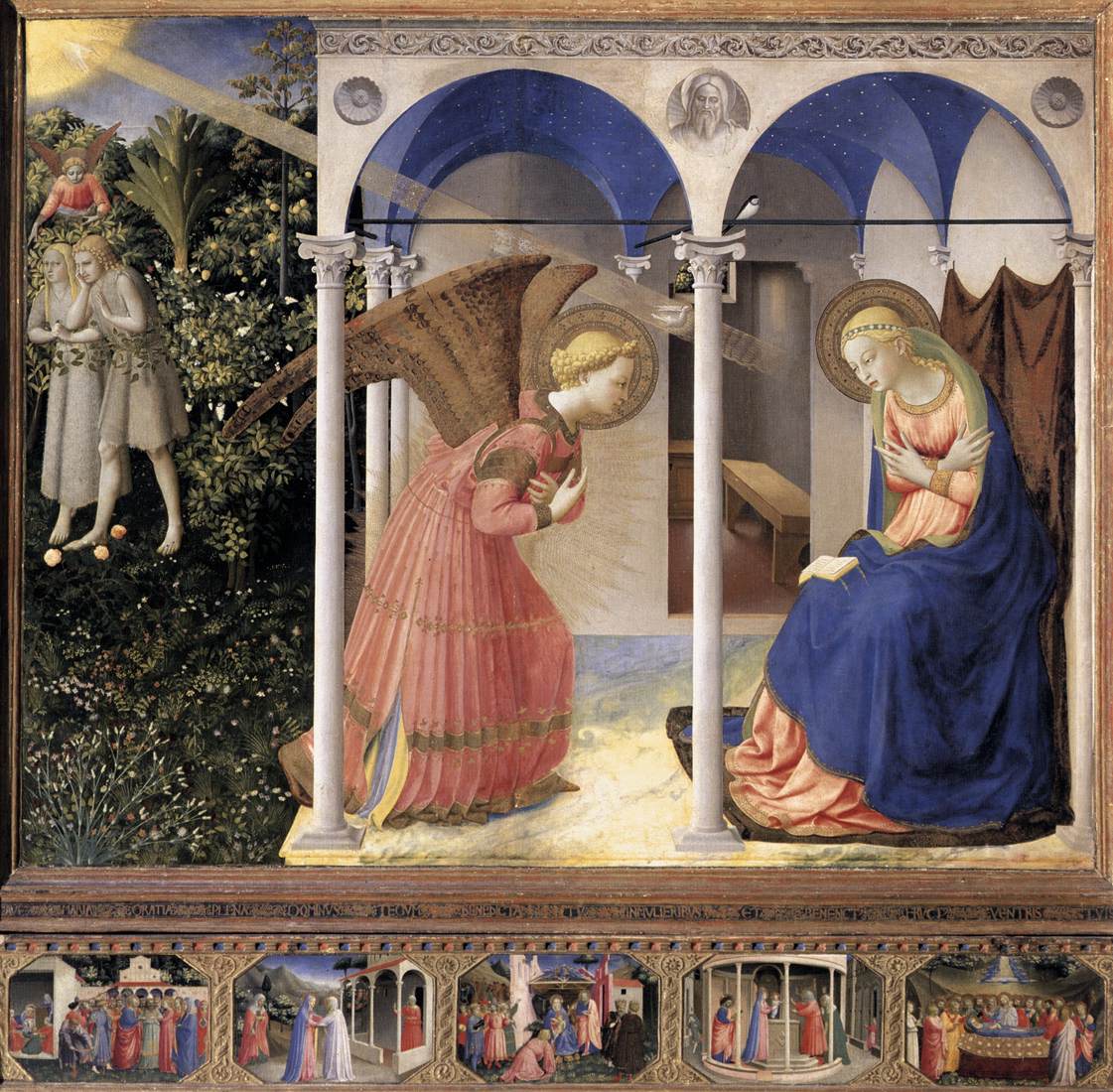.jpg)
FileLa Anunciación (Fra AngelicoPrado).jpg Wikimedia Commons
Fra Angelico's Annunciation in the Prado (c.1430) This earlier Annunciation is the principal painting on the panel known as the Prado Altarpiece. The painting, which was originally commissioned for the Church of San Domenico in Fiesole, was later sold and taken to Spain. Underneath the Annunciation are five small scenes illustrating the story.

14331434 FRA ANGELICO Annonciation détail du retable pour la cathédrale de Cortone Photo
Annunciation (Fra Angelico, Madrid) Annunciation. (Fra Angelico, Madrid) The Prado Annunciation is an altarpiece painted by the Italian Renaissance painter Giovanni da Fiesole, known as Fra Angelico, in the 1420s. It is one of his best-known works. Originally destined for the convent of the observant Dominicans of Fiesole, the painting is.

Annunciation, 1451 1452 Fra Angelico
Produced by: Maria Gracia Turgeon, Habib Attia. Mohamed is deeply shaken when his oldest son Malik returns home after a long journey with a mysterious new wife. 'Annunciation' was created in 1428 by Fra Angelico in Early Renaissance style. Find more prominent pieces of religious painting at Wikiart.org - best visual art database.

The 15 artworks that define Christmas in pictures Annunciation, Painting, Fra angelico
The Annunciation is described in Luke 1:26-28: In the sixth month, Gabriel the angel was sent from God to a town in Galilee called Nazareth, 27 to a virgin engaged to a man called Joseph, from the family of David. The virgin was called Mary. 28 'Greetings, favored one!' said the angel when he arrived. 'May the Lord be with you!'.

Anunciación, La [Fra Angelico] Museo Nacional del Prado
Fra Angelico, The Annunciation and Life of the Virgin (in the predella), c. 1426, tempera on wood, 194 x 194 cm (Museo del Prado, Madrid) Speakers: Dr. Beth Harris and Dr. Steven Zucker The Annunciation is described in the Gospel According to Luke 1:26 - 38. Below is the King James translation: 26 And in the sixth month the angel Gabriel was sent from God unto a city of Galilee, named Nazareth.

L'Annonciation de Fra Angelico 14301450 Musée du Prado Madrid Photo Stock Alamy
Fra Angelico, The Annunciation. by Dr. Beth Harris and Dr. Steven Zucker. Fra Angelico, The Annunciation, c. 1438-47, fresco, 230 x 321 cm (Convent of San Marco, Florence) More Smarthistory images….

Annunciation Fra Angelico encyclopedia of visual arts
20 Feb. The Annunciation by Fra Angelico is one the most beautiful pieces of art of the Florentine Quattrocento. It was painted between 1425 and 1426 by the Dominican monk Guido di Pietro, better known as Fra Angelico. It is located at the Museo Nacional del Prado (Prado Museum), where it entered in 1861 from the Monastery of Las Descalzas.

“Annunciation, The” Fra Angelico, 143845 Renaissance paintings, Fra angelico, L'annonciation
The Annunciation of San Giovanni Valdarno is a painting by Fra Angelico, painted in 1430 to 1432 in tempera on panel. It measures 195 cm by 158 cm. It was looted from Italy during the Second World War by the Germans and returned to the country via the work of Rodolfo Siviero. It is now held at the Museo della Basilica di Santa Maria delle.

the annunciation saying yes and living it catholic dialogue
The Annunciation, by Fra Angelico, 1432-34, in the Museo Diocesano, Cortona, Italy. The Annunciation, tempera painting on panel that was created as an altarpiece in 1432-34 by Italian artist Fra Angelico, one of several works that he painted on the same theme. This is the richest and most beautiful of the versions that he painted on panel.

Fra Angelico en 6 chefsd'oeuvre
The Annunciation of Cortona is a panel-painting altarpiece or retable by Fra Angelico: once housed in the Church of Gesù of Cortona, it is now held at the Museo Diocesano in Cortona. The Annunciation of Cortona was painted by Fra Angelico in 1433-1434, in tempera on panel, 175 cm x 180 cm. This is one of three Annunciations by Fra Angelico on.

Fra Giovanni da Fiesole also known as Beato Angelico Annunciazione di Cortona, 1430 Painting
The Annunciation ( c. 1440-1445) [1] is an Early Renaissance fresco by Fra Angelico in the Convent of San Marco in Florence, Italy. When Cosimo de' Medici rebuilt the convent, he commissioned Fra Angelico to decorate the walls with intricate frescos. This included the altarpiece, the inside of the monk's cells, the friar's cloister, the.

Fra Angelico The Annunciation (143032) Renaissance art, Fra angelico, L'annonciation
Fra Angelico, The Annunciation, c. 1438-47, fresco, 230 x 321 cm (Convent of San Marco, Florence). Speakers: Dr Beth Harris and Dr. Steven Zucker. Created b.

Annunciation Fra Angelico encyclopedia of visual arts
Inventory number P000015/001 Author Angelico, Fra Title The Annunciation Date Ca. 1426 Technique Tempera Support Panel Dimension Height: 162.3 cm; Width: 191.5 cm Provenance San Domenico, Fiesole, until 1611; sold to Mario Farnese, Rome; given to Francisco de Sandoval y Rojas, 5th Marquess of Denia and 1st Duke of Lerma.

Light and Shadow Picture of the day Annunciation by Fra Angelico
Dr. Beth Harris and Dr. Steven Zucker provide a description, historical perspective, and analysis of Fra Angelico's The Annunciation. Fra Angelico, The Annunciation. Fra Angelico, The Annunciation, c. 1438-47, fresco, 230 × 321 cm (Convent of San Marco, Florence). Licenses and Attributions.
.jpg)
Fra Angelico The Annunciation (Convent of San Domenico version), (14251428)
Paris is the capital and most populous city of France.With an official estimated population of 2,102,650 residents as of 1 January 2023 in an area of more than 105 km 2 (41 sq mi), Paris is the fourth-most populated city in the European Union and the 30th most densely populated city in the world in 2022. Since the 17th century, Paris has been one of the world's major centres of finance.
Fra Angelico's The Annunciation in the Cortona Altarpiece Kelly Bagdanov
AboutTranscript. Fra Angelico, The Annunciation, c. 1438-47, fresco, 230 x 321 cm (Convent of San Marco, Florence). Speakers: Dr Beth Harris and Dr. Steven Zucker. Created by Beth Harris and Steven Zucker.